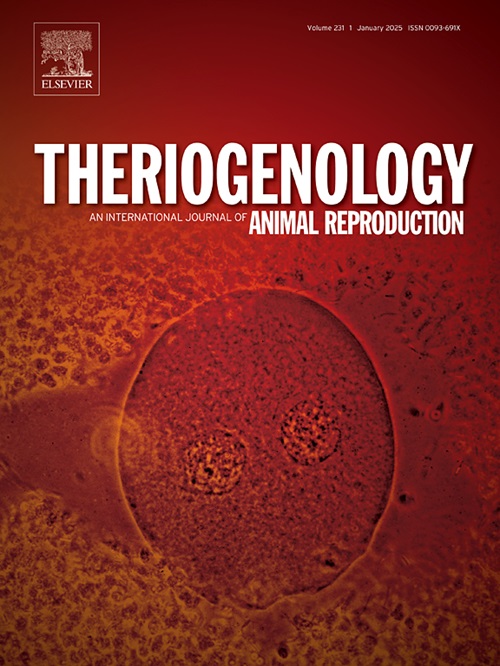饲粮中添加omega-6至omega-3脂肪酸和草药抗氧化剂对公羊精子质量和脂肪酸谱的影响
IF 2.4
2区 农林科学
Q3 REPRODUCTIVE BIOLOGY
引用次数: 0
摘要
在人类和其他动物中,精子中omega-6和omega-3脂肪酸比例的增加与精子参数受损和精子DNA损伤升高有关。本研究探讨了膳食中omega-6与omega-3脂肪酸比例对公羊精子质量、脂肪酸谱和DNA损伤的影响。共有19只Shall公羊被分配到2 × 2因子安排设计中,接受低比例或高比例的omega-6与omega-3脂肪酸(LR:低比例[4:1]和HR:高比例[10:1]),添加或不添加1:1的迷迭香(鼠尾草)和薄荷(薄荷)混合物,持续10周。以不含草药抗氧化剂的HR为对照组。饲喂低脂日粮(P <;0.05)改善精子参数,包括精液量、精子浓度、活力和膜完整性(分别为40%、58%、41%和15%)。此外,饲喂LR日粮的公羊(P <;0.01)精子DNA损伤指数,分别为苯胺蓝、色霉素A3和吖啶橙(分别为36%、90%和68%)。LR日粮增加(P <;0.01)降低了精子中二十二碳六烯酸、二十碳五烯酸和omega-3脂肪酸的浓度,并降低了精子中omega-6与omega-3脂肪酸的比例(71%,P <;0.001),精浆(35%,P <;0.01),血浆(55%,P <;0.001)。总的来说,我们的研究结果表明,在公羊的饮食中添加低比例的omega-6和omega-3脂肪酸,通过将omega-3脂肪酸融入精子结构和精浆中,从而改善精子参数,减少DNA损伤,从而对公羊的精液质量产生积极影响。本文章由计算机程序翻译,如有差异,请以英文原文为准。
Effect of dietary omega-6 to omega-3 fatty acids and herbal antioxidants on sperm quality and fatty acid profile in rams
An increased ratio of omega-6 to omega-3 fatty acids in spermatozoa has been associated with impaired sperm parameters and elevated sperm DNA damage in human and different animal species. The present study investigated the impact of dietary omega-6 to omega-3 fatty acid ratio on sperm quality, fatty acid profile, and DNA damage in rams. A total of 19 Shall rams were allocated to a 2 × 2 factorial arrangement design, receiving either a low or high ratio of omega-6 to omega-3 fatty acids (LR: low ratio [4:1] and HR: high ratio [10:1]), with or without the addition of a 1:1 blend of Rosemary (Salvia rosmarinus) and Pennyroyal (Mentha pulegium) for 10 weeks. The HR without herbal antioxidant considered as control group. Feeding LR diets (P < 0.05) improved sperm parameters including semen volume, sperm concentration, motility, and membrane integrity (40 %, 58 %, 41 %, and 15 %, respectively). Additionally, rams fed with LR diets had lower (P < 0.01) sperm DNA damage indexes, as indicated by aniline blue, chromomycin A3, and acridine orange (36 %, 90 %, and 68 %, respectively). The LR diets increased (P < 0.01) the concentration of docosahexaenoic acid, eicosapentaenoic acid, and omega-3 fatty acids in sperm, and reduced the ratio of omega-6 to omega-3 fatty acids in sperm (71 %, P < 0.001), seminal plasma (35 %, P < 0.01), and blood plasma (55 %, P < 0.001). Overall, our findings revealed that supplementation of a low ratio of omega-6 to omega-3 fatty acids in rams’ diet positively affected their semen quality by incorporating omega-3 fatty acids into the sperm structure and seminal plasma, resulting in improved sperm parameters and reduced DNA damage.
求助全文
通过发布文献求助,成功后即可免费获取论文全文。
去求助
来源期刊

Theriogenology
农林科学-生殖生物学
CiteScore
5.50
自引率
14.30%
发文量
387
审稿时长
72 days
期刊介绍:
Theriogenology provides an international forum for researchers, clinicians, and industry professionals in animal reproductive biology. This acclaimed journal publishes articles on a wide range of topics in reproductive and developmental biology, of domestic mammal, avian, and aquatic species as well as wild species which are the object of veterinary care in research or conservation programs.
 求助内容:
求助内容: 应助结果提醒方式:
应助结果提醒方式:


